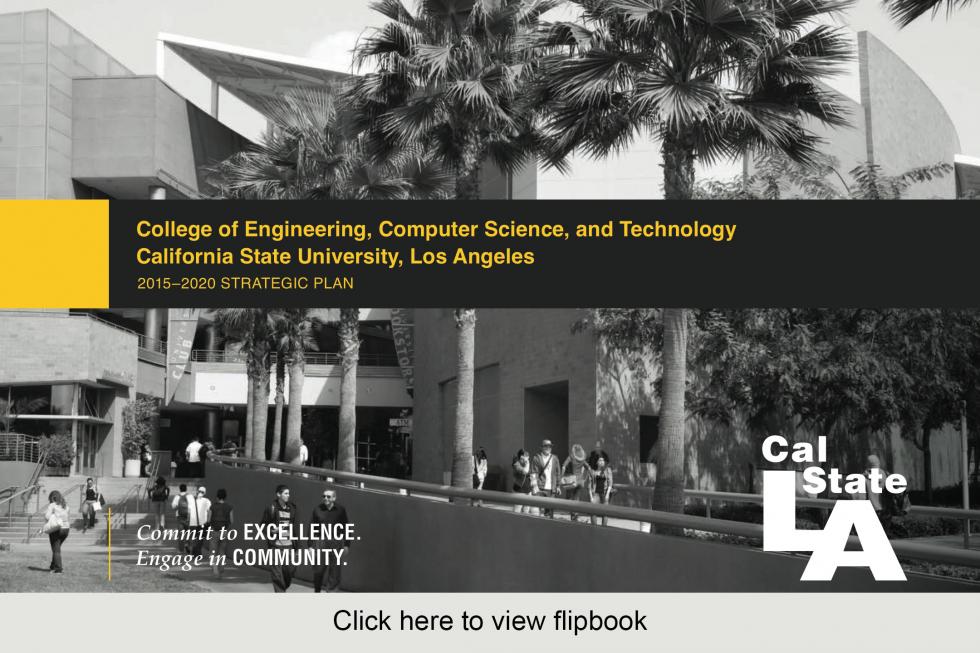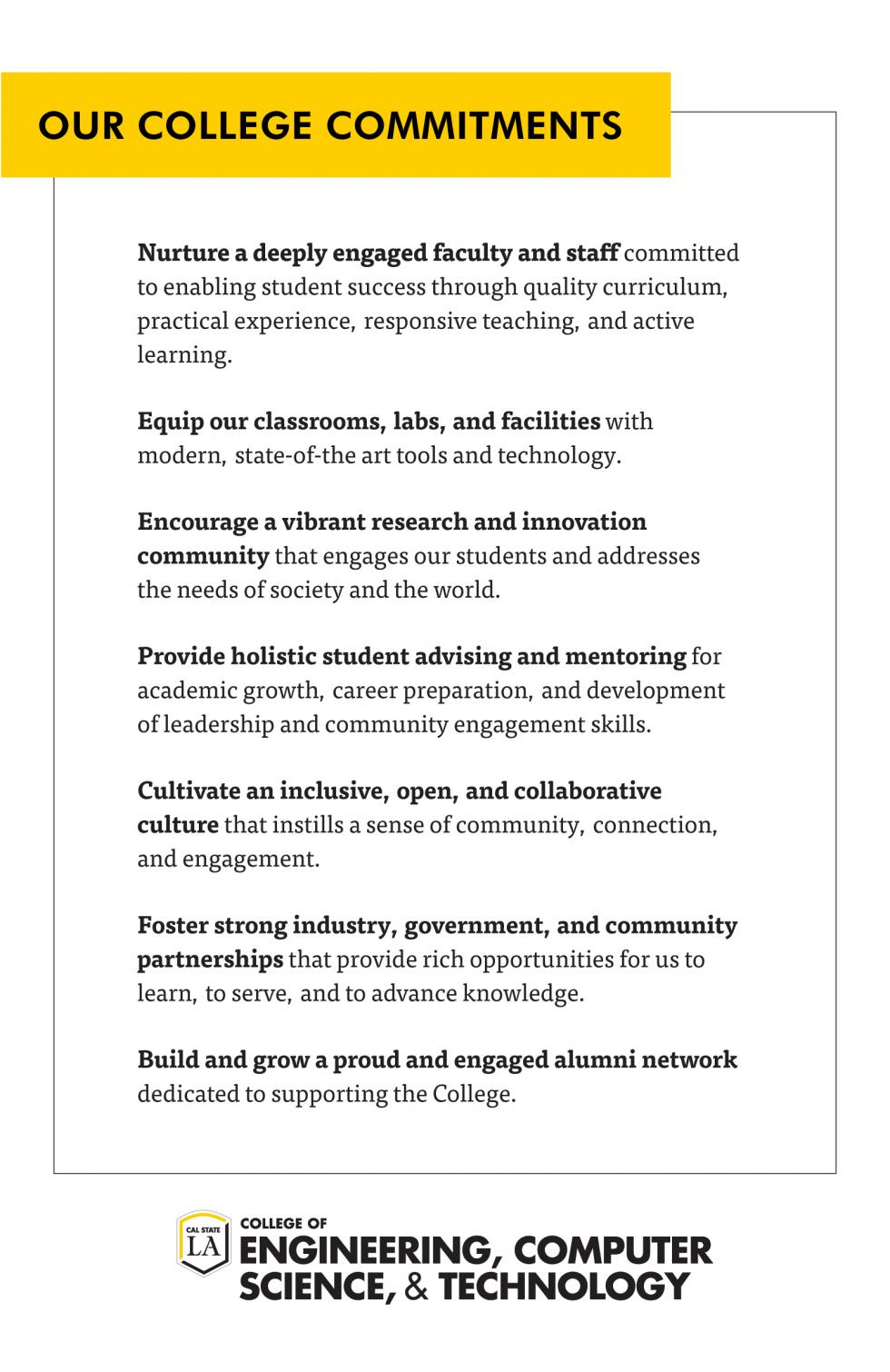Commit to Excellence. Engage in Community.
The College of ECST completed our strategic plan in May 2015. The final strategic planning framework is presented here - we encourage you to open the flipbook below and zoom in to read it page by page or view the PDF file.
Our College Commitments
- Nurture a deeply engaged faculty and staff committed to enabling student success through quality curriculum, practical experience, responsive teaching, and active learning.
- Equip our classrooms, labs, and facilities with modern, state-of-the-art tools and technology.
- Encourage a vibrant research and innovation community that engages our students and addresses the needs of society and the world.
- Provide holistic student advising and mentoring for academic growth, career preparation, and development of leadership and community engagement skills.
- Cultivate an inclusive, open, and collaborative culture that instills a sense of community, connection, and engagement.
- Foster strong industry, government, and community partnerships that provide rich opportunities for us to learn, to serve, and to advance knowledge.
- Build and grow a proud and engaged alumni network dedicated to supporting the College.
Key Milestones and Activities
Key milestones and activities of the strategic planning process:
- Strategic Planning Kick-Off – the Dean introduced the strategic planning effort at a full-day faculty and staff retreat in January 2014. Faculty and staff were asked to provide their perspectives on the key strengths of ECST to build upon, as well as to identify opportunities for further development, growth, or improvement of the college. They also participated in a visioning exercise to provide their input on the future direction and larger purpose and goals of the college.
- Strategic Planning Task Force – a faculty and staff task force (see below) was convened in order to fully develop the ECST strategic plan. Each academic department, as well as the Dean’s office, nominated a representative to be on the task force and serve as a liaison with the broader faculty and staff during the planning process. The task force met for three in-depth planning sessions in Summer 2014 to review all the data available, discuss stakeholder input, and build out the specifics of the plan.
- Data Review – in order to understand the historical context and identify both strengths and opportunities, a comprehensive data review was conducted that included student exit surveys, ECST data and statistics, industry partner comments, and other surveys conducted previously around ECST’s brand and reputation.
- Student Survey – a student feedback survey was sent to ECST’s student population in April 2014 to request feedback on courses, programs, advising, college environment and culture, and a range of other topics. More than 300 students completed the survey, and their feedback was carefully reviewed, summarized, and shared with the Strategic Planning Task Force.
- Dean’s Advisory Board Input – the Dean’s Advisory Board (DAB) is comprised of industry and community partners who dedicate time, expertise, and resources to support ECST. The strategic planning effort and draft materials were shared at the June 2014 DAB meeting, and their input and feedback were collected for consideration and incorporation.
- Faculty and Staff Input Session – faculty and staff were convened once again in September 2014 to give specific feedback on the elements of the strategic plan following the work of the Strategic Planning Task Force over the summer. An interactive workshop was conducted to ensure all faculty and staff could give their input on the proposed mission, vision, values, focus areas, goals, and initiatives.
- Interim Review – feedback from all stakeholders was incorporated into the draft of the strategic plan and reviewed at the faculty and staff welcome back meeting in January 2015.
- Student Feedback – feedback from students was received via several Student Focus Groups in February 2015.
- Final Task Force Review - early March 2015.
Task Force Members
The College of Engineering, Computer Science and Technology Strategic Planning Task Force members were:
- Emily Allen (ECST Dean)
- Trinh Pham (Mechanical Engineering and Honors College)
- David Raymond (Mechanical Engineering)
- Tonatiuh Rodriguez-Nikl (Civil Engineering)
- Elva Popoca (ECST Resource Office)
- Blake Cortis (ECST Technical Staff)
- Candi Marsh (ECST Student Success Center)
- Donna Melendez (Civil Engineering)
- Jianyu Dong (Electrical Engineering)
- Keith Mew (Chair, Technology)
- Russ Abbott (Computer Science)
- Ted Nye (ECST/Northrop Grumman Endowed Chair)
Resource Allocation Plan
The resource allocation plan establishes the distribution of fiscal resources of the University. As defined by Administrative Procedure 212, the University Resource Allocation establishes the policy and procedures for allocating the financial resources of the University. Campus budget allocations are based upon predefined Chancellor’s Office allocations and the campus strategic initiatives. The President provides the preliminary budget guidelines that outline the campus priorities for the following year. The preliminary budget guidelines initiate the university’s Resource Allocation Plan, and these are provided to campus stakeholders for input, consultation, discussion, and information.
College of Engineering, Computer Science, and Technology
5151 State University Dr., Building E&T
Los Angeles, CA 90032-8150
Phone (323) 343-4500 | Fax (323) 343-4555 | Email ecst@calstatela.edu



